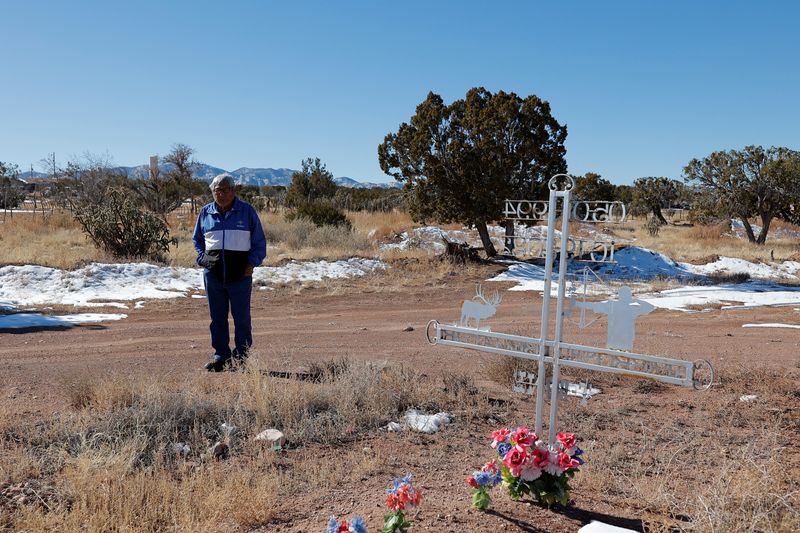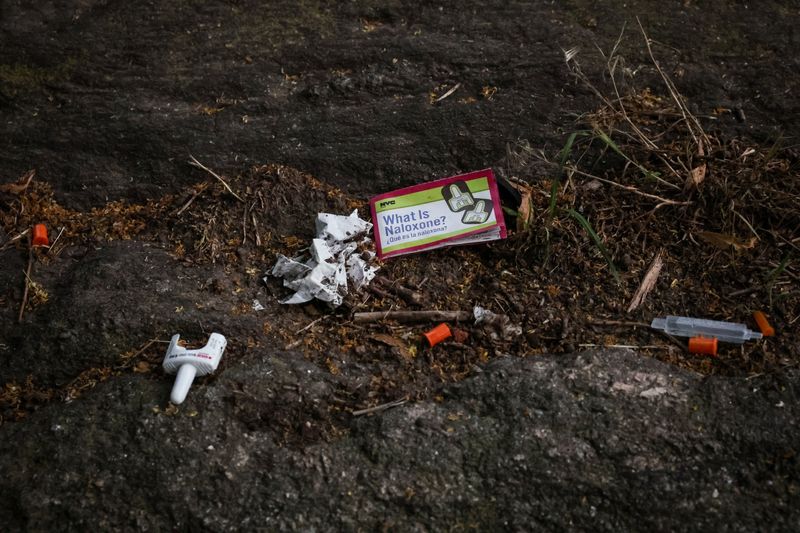By Andrew Hay
ALAMO, N.M. (Reuters) - - Twenty-eight-year old Ambrose Begay died after a fentanyl overdose under a tree 125 yards from his home on the Alamo Navajo reservation in southern New Mexico two years ago.
He is among a generation of young Native Americans losing their lives to drug overdoses in increasing numbers even as such deaths decline nationwide.
Begay's grandfather, Manuel Guerro, 77, passes the spot every day as a school liaison, shuttling students to class and checking on those regularly truant.
Elsewhere, mourners have made shrines to overdose deaths and vehicle accidents among the arid, rolling landscape of one of the poorest reservations in the country.
Guerro decided not to tie a ribbon to the tree for his favorite grandchild, who died Oct. 19, 2022. He did not want the place to remind him of the drug epidemic tearing through his isolated community of around 2,000, which has among the highest overdose death rates in the country.
“It almost took us apart,” said Guerro, a musician, jeweler and comedian whose work is in the National Museum of the American Indian and Library of Congress, as he sat outside the reservation's community center.
Ambrose told his grandfather he felt alone after his father, stepfather, aunts and friends died during the COVID pandemic, Guerro said. In an effort to stop him buying drugs, Guerro used to follow him to homes of reservation dealers, some of whom were "older people" and "respected people." His grandson said "grandpa, they're going to come and kill you," Guerro recalls.
Nationally, overdose deaths declined 21.7% to 89,740 people in the 12 months to August 2024 compared to the same period a year earlier, according to preliminary data from the Centers for Disease Control. But the Alamo Navajo, like other Native American groups as well as African Americans, have been left out.
Overdose deaths on the Alamo reservation have not fallen in the past year, their rate increasing around 306% to 199 per 100,000 residents in 2024 - over six times the national average - from 50 per 100,000 residents in 2023, according to preliminary data from the reservation's health center.
Reversing that trend will require police on the reservation, which currently has none, and closer detox and rehabilitation centers that cater to Native Americans, according to two dozen tribal members and advocates Reuters spoke to. Longer term, the tribe needs to address basic needs like running water and food security for the 56% of its population in poverty, they said. The reservation is an 85-mile drive southwest of Albuquerque, New Mexico's largest city, via a sometimes impassable dirt track.
"LOSING GENERATIONS"
Across the United States, distribution of overdose reversal drug naloxone and more accessible addiction treatment are among factors the Biden administration cited for the fall in overdose deaths.
President Donald Trump’s pre-election promises to stop fentanyl at the nearby Mexican-American border and lower grocery prices resonated with tribal members, many of whom complained of a lack of resources from the Democratic-controlled Navajo Nation and state of New Mexico. Among a flurry of executive orders Trump issued on his first day as president was one declaring drug cartels terrorist organizations.
Trump won the reservation and surrounding Socorro County by around three points on Nov. 5, marking the first time the area backed a Republican presidential candidate in 36 years, part of a rightward shift across Indian country.
In Alamo, peer support worker Harold Peralta, 54, tries to get tribal members into detox and rehabilitation but says many last days or weeks in facilities they consider "jail."
“We’re losing the younger generations, they’re wandering around lost to the drug,” said Peralta, who recalls a tribal member in her twenties reaching out to him for treatment only to die days later of an overdose. "We do have some recover and that's what keeps me going."
The reservation, to which the U.S. government moved the tribe in 1907 after it hid out in mountains to the south, is an enclave one tenth the size of Rhode Island about 100 miles southeast of the vast Navajo Nation.
Alamo Navajos come under the jurisdiction of numerous authorities - their tribe, the Navajo Nation and the United States, as well as Socorro County and the state of New Mexico. Sometimes they have difficulty getting support from anywhere.
“It’s become a nightmare, resources have struggled to get to that community. We’re talking resources from the larger Navajo Nation and the state,” said New Mexico House Representative Michelle Abeyta, whose constituency includes Alamo.
Abeyta, 41, a member of the Navajo Nation who took office Jan. 1, wants to bring drug treatment centers to the area and provide financial support to people who raise the children of family members suffering from addiction, as she does.
Then there is law enforcement.
Julie Guerro, Manuel Guerro's cousin-in-law, recalls when a drug dealer showed up at her front door in September 2023 and threatened to kill her and her husband, alleging a location finder showed his phone was in their house. She said she had no connection with the dealer.
She said it took six hours for a Navajo Nation Police officer to arrive from the nearest station in Crownpoint, about 100 miles away. The officer could not arrest the man because he was non-Native. The Navajo Nation Police Department did not respond to a request for comment.
Alamo residents overpowered the dealer and Socorro County Sheriff’s Office deputies eventually arrested him, said Guerro, 51, a behavioral health case manager at Alamo’s health center.
“It’s going to wipe us all out, our generations are dying before us,” said Guerro, who has tried with little success to get nieces and nephews into drug treatment with suboxone, a medicine used for opioid dependence.
In a reservation home heated by a roaring wood stove, the mother of a 26-year-old addict describes how she and her sons padlock their rooms and refrigerator. The mother, who did not want to be identified, said they try to stop her daughter stealing to pay for fentanyl. A package of ground beef buys a pill.
Tara Jaramillo, a speech language pathologist who is not a tribal member, says reservation children turn to drugs to deal with “generational trauma” from 19th century ethnic cleansing, Indian boarding schools, COVID deaths and parents' addictions.
“These children do not have food, they may not have running water, they may not feel safe at night,” she said.
Jaramillo, a former Democratic state house representative who went to school on the reservation, was defeated in the Nov. 5 election by Republican Rebecca Dow who ran on promises to secure the U.S.-Mexico border.
"Fentanyl deaths and overdoses and addiction have touched the life of every family that we talked with and the Democrats have done nothing about it," said Dow, who represents a district bordering the reservation.
A SOLUTION
At the front desk of a Walmart (NYSE:WMT) in Taos, New Mexico, tribal member Myreon Apachito, 31, works as a team leader. He did seven months of rehab in Taos last year for addiction to heroin, meth and fentanyl.
He hopes to break his family's cycle of addiction. His parents, both former alcoholics, are an inspiration.
"My mom said the reason she started drinking was trauma passed down from her parents, and me doing drugs was because my parents were never there," said Apachito, who plans to stay in Taos.
In Alamo, he said fentanyl was easy to get from dealers at prearranged spots on Interstates 25 and 40, drug transit routes to the east and north of the reservation.

The Alamo reservation’s last full-time cop, Cecil Abeyta, Michelle Abeyta's father-in-law, who retired 12 years ago, is now a member of its powerful school board. He is trying to set up a detox center and bring in federal and Navajo police to bust dealers.
“There’s got to be a solution to it, there can’t be no solution," said Abeyta, 64, who recently recruited two tribal members to train as reservation police.
